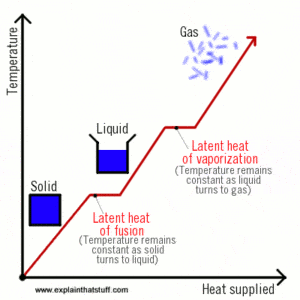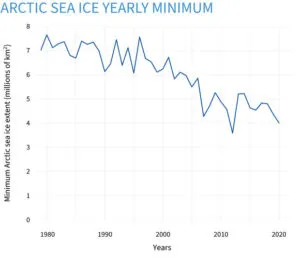Why you should care about The Latent Heat of Fusion of Ice to Liquid Water

Why is this topic a big deal?
To melt 1 gram of ice requires 80 calories – the same amount of energy needed to raise one gram of water 80°C.
That means that a large amount of global heating is being masked by the fact that this excess heat is being use to melt ice and not heat the air or water. Once the ice is melted, as is now happening to the Arctic Ocean ice [which has lost 72% of its mass since 1980], that energy will finally be used to heat the water or air. That’s when global warming really begins, everything so for is basically just a warm up.
If you’re an engineer like I am this is a very sexy topic. For the rest of you, I apologize for the seemingly geeky title but I hope by the end of this essay you too will think of the Latent Heat of Fusion as an exciting and profound concept.
First off, we had better start with some definitions.
latent heat of fusion is the change in its enthalpy [internal energy within its chemical bonds] resulting from providing energy, typically heat, to a specific quantity of the substance to change its state from a solid to a liquid. This means you can ice at 0 C and water at 0 C but the energy of water is MUCH more than that of ice.
Specific heat (C) is the amount of heat required to change the temperature of a mass unit of a substance by one degree. This is what most of us consider – heat increases the temperature of a substance. It turns out that with water it takes MUCH more energy to change the state of water [ice to water] than to heat it.
Albedo – a number indicating how much light is reflected off a substance. A typical ocean albedo is approximately 0.06, while bare sea ice varies from approximately 0.5 to 0.7. This means that the ocean reflects only 6 percent of the incoming solar radiation and absorbs the rest, while sea ice reflects 50 to 70 percent of the incoming energy.
Arctic [and Antarctic] sea ice keeps the polar regions cool and helps moderate global climate. Sea ice has a bright surface; 80 percent of the sunlight that strikes it is reflected back into space. As sea ice melts in the summer, it exposes the dark ocean surface. Instead of reflecting 80 percent of the sunlight, the ocean absorbs 90 percent of the sunlight. The oceans heat up, and Arctic temperatures rise further.
A small temperature increase at the poles leads to still greater warming over time, making the poles the most sensitive regions to climate change on Earth. According to scientific measurements, both the thickness and extent of summer sea ice in the Arctic have shown a dramatic decline over the past thirty years.
Simply put, we are destroying the air conditioner that keeps the world in balance. Here is a little “detail” that is important to know as it adds some drama to the story. When life started on Earth the sun emitted 30% less energy than today, as when starts age they emit more energy. Thus, when life began, global freezing was a problem so high concentrations of greenhouse gases like methane and carbon dioxide was a good thing – it kept us from freezing [although there were still multiple “snowball earth” events]. Today we have the opposite problem. For life to exist we need ice, we need our conditioner, to keep us cool as the sun, ever so slowly, over millions of years, emits more energy. To repeat, without ice we are F—-ed.
So, what can you do? Given the rather lame “commitments” coming from COP26, which are all trying to keep BAU [business as usual] going, be ready to adapt to a warmer world. Move in you live in a climate danger zone. Talk and live about our need to change how we live to achieve net zero carbon – who cares if our standard of living goes down a bit if where we live is under water or turns into a desert or is flooded or worse! Mostly, don’t freak out and in spite or what I am saying remain optimistic – but an optimism coloured by a realism that admits that short term pain [in the hundreds of years] seems to be necessary before we do what we must. As I tell all my friends, we, as frail human beings, behave in strange and irrational ways that are built into us and can only be changed with great, great difficulty as this quote makes clear:
Change happens when the pain of staying the same is greater than the pain of change.

Good basic article to introduce people to the concept of how global ice acts as a thermal regulator.
It would be useful for the author to proof-read and make some corrections that make the article confusing some someone just curious about the subject.
Thanks!
nice quick explanation of heat of fusion and aladebedo and imporance as buffers climate change buffers. The next step would be estimate of relative importance based to slowing change based on percent ice occupies of planet water and planet surface area, and then estimating when an increased rate of temp rise will start and how much faster it will be then up to now. Based on this, could turn out that vanishing glaciers might or might not be major factor, but we ought to have that info. Is it available anywhere?
thanks for you feedback and I am glad you enjoyed the article